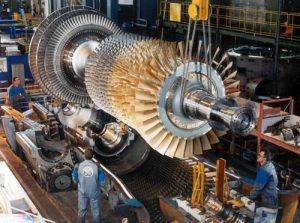The incremental rotor balancing procedure
The methods employed in shop balancing can have a profound impact on the resulting balance condition of the rotor. The impact of shop balance technique is most important when the rotor is relatively flexible and/or long as is common with most turbomachinery.
The article contains excerpts from the paper, “Rotor balancing tutorial” by Ray Kelm, Dustin Pavelek and Walter Kelm of Kelm Engineering presented at the 2016 Turbomachinery Symposium.

To improve the balance condition of most high speed flexible rotors, the following procedure is generally followed:
1. Balance the bare shaft without added components
a. Assure that any keyways are fitted with half keys in accordance with ISO 8821 unless two keys are located at the same axial position and are 180⁰ apart
2. Balance the attached components separately to ISO 1940 grade G1 or better
a. Balance should be accomplished normally using shop mandrels or other balance hardware. Mandrels should be precision balanced and have eccentricity <0.0001 in and a mass of <25% of the component to be balanced.
b. Concentricity of mounting hardware such as mandrels during the shop balancing should be adequate to prevent mounting eccentricity that can result in component balance error that exceeds the intended balance tolerance
3. Mount no more than 2 components to the shaft at a time and re-check balance, and if corrections are required only correct on the added components
4. Perform a check balance on the fully assembled rotor after the component assembly procedure above, with final corrections normally on two correction planes near the ends of the rotor (near bearings)
a. Check balance process will normally allow limited balance correction, since major corrections would have been completed during assembly
b. “Large” corrections to an assembled rotor pose a nontrivial risk of vibration above the first critical speed due to modal balance, since large unbalance (that could be located away from balance correction planes) can be corrected to minimize shop balance machine output to comply with the 4W/N rule at the two planes defined but not correct the modal balance condition for higher flexible rotor modes.
The motivation for following this incremental balance procedure is to minimize the unbalance of the rotor in general, but to specifically reduce the modal unbalance that can result if this method is not followed. If the rotor is fully assembled and balanced after being fully assembled (opposed to the incremental balance), unbalance of components or more specifically the mounting eccentricity of the components can result in very large modal unbalance even though a low speed balance machine may indicate that the rotor is successfully balanced.

.png&w=3840&q=75)

.png&w=3840&q=75)



.png&w=3840&q=75)



.png&w=3840&q=75)









